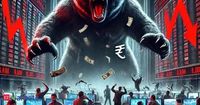The tremors are a direct echo of Wall Street’s bloodbath, where fear of a US recession is spooking investors. JPMorgan has sharply raised the odds of a downturn to 60%, citing Donald Trump’s bombshell announcement of sweeping tariffs—what the bank called the biggest US tax hike since 1968. In the mother market, the US, the Nasdaq has officially entered a bear market—down around 23% from its December highs. The Dow isn’t far behind, trailing with a 15% slide.
Riding the global panic wave, Nifty50 has dropped nearly 17% from its September peak—just ~700 points shy of the technical bear market threshold of 21,022. Make no mistake: Dalal Street isn’t immune despite India being Trump’s tariffs being relatively less harsh on India directly. And the symptoms are starting to show. Geojit Financial Services is now wondering whether we need to brace for a Covid-like event, where the collapse was dramatic in terms of losses as well as speed.
But “normal” has left the building. “None of it applies this time,” said a senior fund manager at a global asset firm. “When the fear of recession grips, even the sweetest macros get bitter. Investors flee to safety across asset classes. And India, like always, is part of the global risk-off trade.” Ajay Bagga, market veteran, issued a stark reminder. “We made the same mistake in 2008, and again in 2013—saying India is decoupled. When the risk-off happens, people start looking at pockets of liquidity and our exits are very large. We provide good exits to anybody wanting to take out money.”
Indeed, India’s fundamentals remain solid: inflation is relatively under control, the rupee is behaving, and corporate earnings—especially among domestic-focused sectors—are holding up. That’s why some strategists are urging investors not to panic, but pivot. “Our think tank advises reducing portfolio beta,” said Jitendra Gohil, Chief Investment Strategist at Kotak Alternate Asset Managers. “Reallocate towards domestic-focused sectors like banking and financials. With the dollar softening and oil prices correcting, India could show near-term outperformance. But lower your return expectations and diversify.”
Yet the uncertainty looms. Federal Reserve Chair Jerome Powell, in a not-so-comforting tone, said the fight against inflation could take “longer than expected,” thanks in part to the very tariffs Trump introduced. If U.S. inflation refuses to budge, expectations of rate cuts—a key support for equity valuations—could face a serious reality check. So, will Nifty follow Nasdaq into the bear zone? The odds are rising, but not inevitable. India’s resilience may hold, but if global investors start dumping risk in earnest, no market is sacred. For now, India has a cold. But if Wall Street’s fever spikes any higher, don’t be surprised if Dalal Street starts sweating too.
Meanwhile, the Reserve Bank of India is likely to extend its record cash infusions into the banking system as it shields the economy from mounting global headwinds, analysts say. This move comes as the Australian sharemarket plunged 3.8% in early afternoon trading, paring losses of more than 6% at market open. The benchmark S&P/ASX 200 index was down 3.81% to 7,375.9 at 1:30pm AEST.
The energy sector, which had earlier shed nearly 10%, was down 5.6%. Oil giants Santos (-8.6%) and Ampol (-8.2%) remained two of the market's worst performers. Materials (-4.7%) was the next worst performing sector, followed by financials (-4.3%). Mining giants BHP (-5.2%), Fortescue (-4.6%) and Rio Tinto (-3.5%) trimmed declines, as did big four banks Commonwealth Bank (-5.2%), ANZ (-4.1%), Westpac (-3.9%) and National Australia Bank (-3.9%).
Elsewhere, Hong Kong's Hang Seng index was down more than 9% and China's CSI300 blue-chip index fell more than 5%. The Australian dollar has dropped below 60 cents for the first time in five years, extending losses after sustaining a heavy fall on Friday. By 10:45 am, the Aussie dollar was trading at 59.95 US cents. It had dropped to a low of 59.44 US cents earlier in trading on Monday.
The slide comes after China retaliated to US tariffs by announcing a 34% tariff on all US imports, raising fears of a trade war between the world’s two biggest economies. Asian stocks slump, joining the global selloff amid growing concerns of an escalating global trade war sparked by Trump’s sweeping tariffs. Japan's Nikkei sank 7.8% in early trading to its lowest level since late 2023, while South Korea's KOSPI index lost 4.6% after opening.
In Europe, shares look set to open deep in the red as global markets go through heightened volatility caused by extreme uncertainty over how Trump’s tariffs will evolve. The European Union is likely to join Canada and China against Trump's tariffs. Countries like Japan, Mexico, South Korea, and India are seeking concessions from the U.S. rather than retaliating. Others like Vietnam and Cambodia are negotiating lower tariffs or asking for delays.
Britain is still hopeful that any tariffs imposed by Trump will be reversed shortly, if the two sides can agree on the outline of a new economic partnership. Futures linked to Wall Street's indexes have tanked on Sunday evening as Trump's top economic officials dismissed investors' fears of inflation and recession even after a two-day historic stock market rout. Trump on Sunday said that sometimes you have to take medicine when asked about falling markets, adding that the U.S. was treated so badly by other countries.
U.S. Commerce Secretary Howard Lutnick told CBS News that the tariffs will stay in place for days and weeks. Treasury Secretary Scott Bessent downplayed the stock market drop and noted to NBC News that more than 50 countries have approached the administration for negotiations. Amid global trade tensions, investors piled into safe haven assets such as bonds, the Swiss franc, and the Japanese yen.
A rally in U.S. government debt sent the U.S. two-year yield to touch the lowest since 2022. Copper fell more than percent and gold plunged to a 3-1/2-week low below $3,050 per ounce, while oil extended last week's steep losses to hit a four-year low as Saudi Arabia slashed its flagship crude price by the most in more than two years. Federal Reserve Chair Jerome Powell said in remarks at a business journalist conference that it is becoming clear that the tariff increases will be significantly larger than expected and the same is likely to be true of the economic effects, which will include higher inflation and slower growth.
In summary, the global financial landscape is shifting dramatically, with markets reacting sharply to the uncertainties surrounding tariffs and economic policies. Investors are advised to remain vigilant and adapt to the evolving situation as the implications of these tariffs unfold across the globe.






